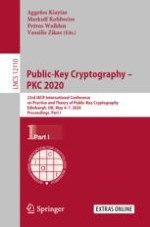2020 | OriginalPaper | Buchkapitel
Witness Maps and Applications
verfasst von : Suvradip Chakraborty, Manoj Prabhakaran, Daniel Wichs
Erschienen in: Public-Key Cryptography – PKC 2020
Aktivieren Sie unsere intelligente Suche, um passende Fachinhalte oder Patente zu finden.
Wählen Sie Textabschnitte aus um mit Künstlicher Intelligenz passenden Patente zu finden. powered by
Markieren Sie Textabschnitte, um KI-gestützt weitere passende Inhalte zu finden. powered by
